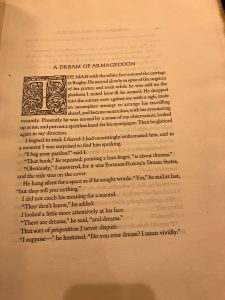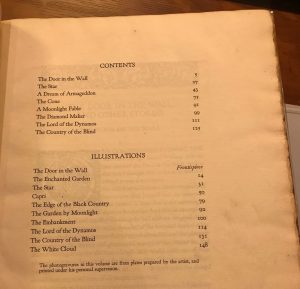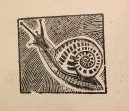A Tale of Armageddon by Kunal S.
“A Dream of Armageddon” was first published as a stand-alone short story within a British weekly magazine in 1901. In the story, a man riding a train meets an elderly man who begins to discuss a very vivid dream that he has had. In the elderly man’s dream, he is a major figure who gives up his leadership role in order to pursue love. However, his successor is ruthless and begins a war during the man’s absence. This war leads to devastation and ultimately the death of his lover and himself within the dream.
The short story was fairly popular and was re-published in 1911 within a collection named “The Door in the Wall And Other Stories” by H.G. Wells. In addition to the stories themselves, the collection also contained an illustration associated with each individual story.
My very first thought upon seeing the collection was that the book was physically massive. The book itself is nearly two feet tall! It is oversized to the point of being comical. With such size, the book appeared more like a children’s book filled with fantastical fairy tales rather than serious stories delving into complex ideas related to our inherent human desires, as is the case for “A Dream of Armageddon.” This fairy tale-like appearance is further supported by the artistic calligraphy used upon the first character of each story. I associate this style of script with old fairy tales, such as those written by the Brothers Grimm several centuries ago. By using this script to start every story within the collection, the object further defines the stories themselves as whimsical and geared towards children. This is in stark contrast to the serious nature with which I read “A Dream of Armageddon” initially outside of the context of the collection.

When looking at the other stories within the collection, I see titles such as “The Lord of Dynamos” and “The Diamond Maker.” The titles of these other stories reference lords and diamonds which are both often featured in fairy tales due to their association with royalty and kingdoms. This further promotes the reading of “A Dream of Armageddon” as a fairy tale.

Finally, I found the illustration associated with “A Dream of Armageddon” to be a bit surprising. Wells ̶ along with the illustrator, Coburn ̶ chose Capri under siege by a warship as the illustration with which to depict the story. This illustration shows the picturesque and serene nature of Capri alongside the bleak and stark nature of the warship. This contrast helps highlight the negative effects of war on society. The image as a whole appears a bit mystical given the shimmer with which the edges of the illustration are drawn. This artistic style gives Capri a magical appearance that separates it from reality, a trait that often characterizes locations within fairy tales. Overall, the illustration promotes readings of “A Dream of Armageddon” that emphasized the idea of the Capri being an escape from reality and the war itself being the central feature of the story, rather than interpretations that focused on the man shirking his responsibility and ultimately getting his lover killed through war.

The presentation of the short story within the illustrated collection promotes the reading of “A Dream of Armageddon” as a fairy tale with a focus on the ill-effects of war rather than as a science-fiction story that focused on the human condition of love as a distraction. In my view, fairy tales contain an overarching moral that serves as the guiding message throughout the story. This message is meant to serve as a moral authority to the reader. This is the case for traditional fairy tales such as “The Tortoise and the Hare” or “The Boy Who Cried Wolf.” And I believe that this is also the case for “A Dream of Armageddon” which teaches that war is bad and should be avoided at all costs when interpreting the short story from the lens of it being a fairy tale.
On the other hand, science fiction and fantasy are genres that fundamentally write about the human condition without acting as a moral authority on the issue. Despite taking place in settings clearly separate from those found in reality, the characters are strikingly human in their desires and intentions in a way that is strangely relatable to the reader. For “A Dream of Armageddon,” Wells uses the idea of love distracting someone from their duty as the human characteristic that makes the story relatable to the reader. The story doesn’t make a moral statement regarding whether the character’s actions were right or wrong. That is left open to the reader’s interpretation, which I think is the key differentiating factor between fairy tales and fantasy stories.
Overall, seeing “A Dream of Armageddon” within this collection shifted my focus on the piece from abstract human ideas related to love and responsibility towards ideas more closely associated with the morality of war. This shift can be clearly demonstrated when thinking about one of the passages within the piece after the war broke out.
“Love had come to me with her eyes and robed in her beauty, more glorious than all else in life, in the very shape and colour of life, and summoned me away. I had silenced all the voices, I had answered all the questions–I had come to her. And suddenly there was nothing but War and Death!” (Wells, “A Dream of Armageddon”)
Initially, I interpreted this passage as being about how love provided him an escape from his previous life that had followed him despite of his best efforts to ignore it. In essence, love and its role in his life was the focus of this quote. However, upon seeing the story within the object and reading the story through the lens of it as a fairy tale, I now see the quote as being more focused on the destructive nature of war. I interpret the quote as lamenting how the war robbed him of his new-found happiness and thus driving home the idea that war is bad and ought to be avoided. This interpretation shifts the focus of the story on how war can destroy even the happiest of lives.
Purely from the text, both of these interpretations have a degree of validity. But, I would argue that seeing the story within the context of the illustrated collection pushes readers further towards the fairy tale interpretation of the story, rather than the fantasy/science-fiction interpretation.










Recent Comments